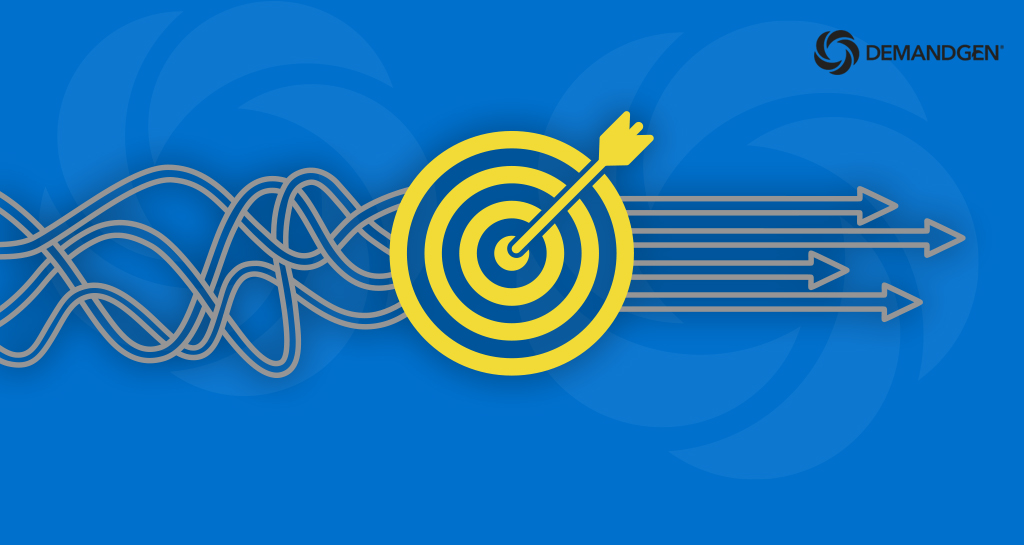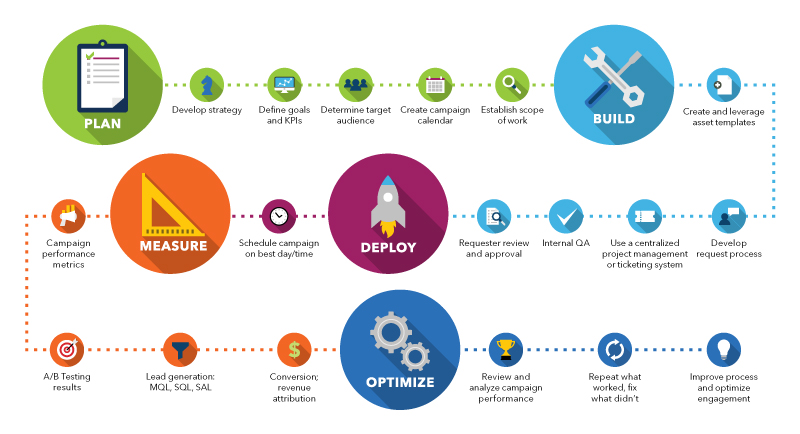
Over the years I’ve managed teams of campaign specialists for small, midsize, and enterprise organizations. I’ve worked with several different marketing automation platforms, and I’ve overseen new implementations, integrations, replacements, and the accompanying process changes and improvements. That’s not even counting the hundreds of ones my team has managed for our clients here at DemandGen.
When someone asks what keeps me up at night, I don’t have to stop to consider my answer. It’s already kept me up many a night: “How can I optimize every aspect of the entire campaign planning and execution process?”
I’ve been working on perfecting the campaign process for almost two decades. That’s a long time to spend thinking about each step from start to finish and tinkering with different ways to iron out any wrinkles that tend to pop up time and time again (and I’ve witnessed my fair share).
I’ve already encountered just about every wrinkle imaginable, so I’ve spent a great deal of time figuring out how to smooth each one out. And the answer isn’t magic, good luck (although that certainly helps), or even the perfect mix of personalities.
It always comes down to planning, process, and repeatable workflows. ALWAYS.
“Before anything else, preparation is the key to success.”
Alexander Graham Bell
It may not sound exciting, but smooth campaign planning and execution can be a very beautiful thing. That’s because once you get it down, you can demonstrate 1) how you consistently meet your deadlines, 2) how much time you’ve saved, and 3) how much you’ve improved your campaign performance.
That’s right — the continual analysis and refinement that are part of a well-optimized campaign planning and execution process can even help drive positive engagement and results.
Optimizing the five core areas of campaign planning and execution
After decades of thinking about and fine-tuning the entire campaign process, I’ve broken it down into five core areas. Read on to see how your current processes stack up in each category:

- Plan
The majority of marketers skip this critical step, usually due to a lack of time. I get it. We’re all busy. But, the only way to minimize or even eliminate the seemingly neverending back and forth involved in building and deploying each individual campaign request is with careful planning, so it’s worth the upfront time investment in the long run.
- Define the goal of your campaign: This ensures that everyone is on the same page and working toward the same metrics (e.g., generate X leads that will eventually generate X amount of revenue).
- Develop a campaign strategy: Be sure to include expected KPIs, such as leads generated (MQL, SQL, Customer). Are you going to do A/B testing to analyze and optimize campaign performance? Hint: Yes, you should make this a priority.
- Create a campaign calendar: Decide on day and time of send based on best practices and analysis of prior campaign performance. Be sure to factor in any other campaigns you’re sending to the same audience around the same time. This step helps to accommodate various schedules and ensures all necessary stakeholders have the chance to approve the piece before it’s sent out.
- Establish a Level of Effort and Statement of Work policy: Set expectations upfront so that requesters know how much lead time you need for every type of campaign, and the average amount of time it takes to complete each individual step of the process.
- Build
There’s one on every team. That individual who keeps coming back with small tweaks and changes to a single campaign. What would normally take 2 to 3 hours to build and setup a campaign for deployment ends up taking 3 to 4 times as long with all the back and forth, consuming valuable resources, time, and money. Optimizing the building phase requires effective and efficient collaboration and communication among team members:
- Create reusable email templates: I highly recommend doing this first, but the most important thing is to do it when you can — especially if you send out a high volume of campaigns. Creating templates that can be copied and reused across multiple campaigns eliminates rework and leaves more time to focus on honing the message (or getting more campaigns out the door).
- Develop an intake form: Make it as easy as possible for your requesters to give you what you need by creating a standard campaign request form. In addition to content and design elements, be sure to make it easy for them to provide their list requirements. After all, if the campaign doesn’t go to the right people, did it ever actually exist in the first place?
- Submit a campaign brief: Provide a detailed campaign brief to whomever is going to build and deploy the campaign in your MA platform. Be sure it covers every single component — from design elements to list requirements — to minimize any additional back and forth.
- Use a centralized project management or ticketing system: The greatest benefit of having a central repository is having everything in one place instead of floating around somewhere in the email universe. Manage new campaign requests, determine process and workflow, assign work, and keep all communication and campaign assets in one central location. Whatever system you use, make sure it’s easily accessible for everyone involved in the campaign process. Since every aspect of the campaign process becomes visible to all stakeholders, an additional benefit also tends to be fewer ad-hoc change requests. In any case, the historical tracking will definitely explain any hiccups or delays that you can point to when recommending future changes to the existing process.
- Always make time for internal QA and testing: Once completed, conduct an internal QA test and review. Don’t skip this step, because someone will eventually tell you there’s a mistake — after your email has gone out to 15,000 prospects.
- Get final sign-off: Last but not least, pass it back to the initial requester for final review and approval. This third set of eyes ensures the campaign has been flawlessly built to expectations.
- Deploy
You’ve planned your strategy and you’ve created your campaign assets, so the next part is hitting send, right? Not so fast. When you send your campaign can impact results, so figure out which days and times of the week perform best for your audience:
- Schedule an optimal delivery window: Does morning or afternoon tend to work better for open rates and click-throughs? What about Mondays versus Thursdays? Look to industry benchmarks and your historical campaign performance to get an idea of when your audience is most receptive to your email. Testing different days and times will be beneficial in nailing down the optimal ones for you.
- Measure
Reporting and analysis are often the second thing to fall by the wayside when people are short on time (the first is planning). But, if you ever want to create a more efficient and effective campaign process, you can’t skip this step. And it’s critical to define your metrics and reporting processes before the campaign goes out (see Step #1). Campaign benchmarks vary widely from industry to industry, and even company to company. While standard industry benchmarks are a good place to start, I recommend benchmarking yourself against your organization’s historical campaign results. After all, the end goal is to improve your campaign performance and convert more qualified leads into revenue-generating customers.
- Measure campaign engagement: Track email open rates, click-through rates, time on web page, and so on. Just make sure you’re measuring the same variables across all campaigns so you can truly compare apples to apples.
- Look beyond email metrics: Important KPIs include not only email metrics, but also campaign volume, team efficiency, request processes, and utilization, because these are the metrics that will help you further refine and optimize your campaign processes and team performance.
- Analyze what worked and what didn’t: At a set interval after each campaign, gather everyone to discuss ideas for improving the next campaign. Maybe you test a graphic-heavy email versus one with mostly text. Maybe you test the color of your CTA button. Just make sure you do it in a thoughtful, measurable way — and not just because your campaign requester prefers the color blue.
- Optimize
Now it’s time to take everything you’ve learned and put it to good use — otherwise, you’re just doing the same thing over and over again and expecting different results (which happens to be the definition of insanity):
- Improve your campaign process: Analyze and optimize your existing campaign processes and workflows to make efficient, effective, and flawless campaign execution a reality.
- Optimize future campaign engagement and performance: Take everything you’ve learned from your analysis and determine your next steps based on best practices (e.g., A/B testing; CTA placement, size, and color; graphic vs. text-looking email; audience segmentation criteria; send day and time).
Improvement is a journey, not a destination
There are a lot of moving parts when it comes to planning and executing campaigns. The most important thing is to get started. Identify your biggest area for improvement and start there. Or, begin where you have the most buy-in from other team members. Every marketing team’s journey is unique based on your available resources, the number of campaigns you send, your target audience, and which tools you already have in place.
Sometimes it’s nice to get a helpful push in the right direction. That’s why we created DemandGen’s Campaign Process Optimization (CPO) service. Our team of seasoned campaign managers can help you optimize your campaign processes and related activities to enable a scalable, repeatable, and consistent way of planning, building, deploying, measuring, and optimizing your campaigns. Even better, let us build and deploy your campaigns for you through our Campaign Execution Services so you can stay focused on strategy and planning.
If you’re among the 78 percent of marketers too busy to properly plan or measure your campaigns, it might be time to enlist DemandGen for support. Contact us to learn more about how your team can start saving time and money while improving campaign results with our proven process optimization strategies and execution services.
 John Bokelmann leads the Managed Services team that supports DemandGen clients in digital marketing campaign development, production, and deployment. He provides strategic marketing operations leadership, develops and implements optimized workflow processes, and reinforces marketing best practices for both B2B and B2C clients.
John Bokelmann leads the Managed Services team that supports DemandGen clients in digital marketing campaign development, production, and deployment. He provides strategic marketing operations leadership, develops and implements optimized workflow processes, and reinforces marketing best practices for both B2B and B2C clients.
The post From Idea to Inbox: Optimize Your Entire Campaign Planning and Execution Process Across 5 Core Areas appeared first on DemandGen.
About the Author



















